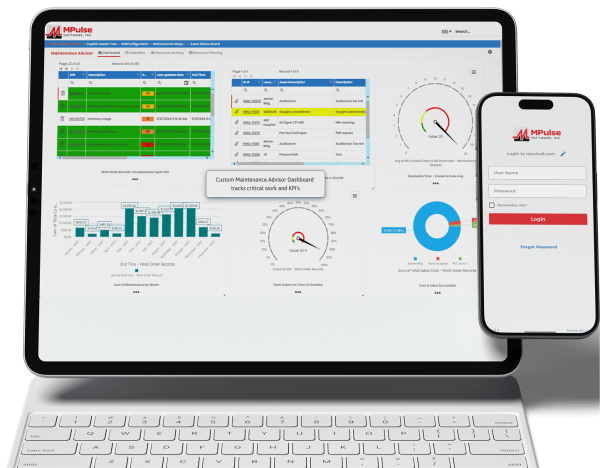Implementing CMMS in manufacturing enhances equipment maintenance, reduces downtime, and improves overall operational efficiency, leading to increased productivity and cost savings. Manufacturers face multiple challenges in today’s global marketplace, and these market conditions can squeeze tight profit margins.
At the same time, advances in automation, robotics, artificial intelligence, and other technologies are transforming the manufacturing landscape, requiring companies to continually adapt to stay competitive.
Successful manufacturers understand the need for innovation to adapt to these changes. These businesses continually look at new technologies and different approaches to find better ways of doing things.
Table of Contents
Reasons to Implement CMMS in Manufacturing
CMMS software offers solutions for manufacturers, and companies are making the switch for one or more of the following reasons.
Reason #1: Equipment Reliability and Availability
CMMS software can improve the way manufacturers manage their maintenance activities, leading to more reliable equipment and reduced downtime. It starts with the adoption of data-driven management, backed by CMMS, which simply means making decisions backed by reliable data instead of assumptions or perceptions.
As CMMS technology has advanced, more detailed, relevant data on manufacturing assets is now available. And that data reveals some interesting things, including how the maintenance team can improve operations and streamline workflows. By tracking equipment performance and maintenance activities with CMMS software, manufacturers can identify potential issues and take proactive steps to address them.
Reason #2: Increased Efficiency
Customers increasingly expect customized products and fast delivery times, requiring manufacturers to be more flexible and responsive to changing market demands. By automating maintenance processes and tracking equipment performance, CMMS software can help manufacturers optimize their maintenance schedules, reduce costs, and improve efficiency.
CMMS software can generate detailed reports on equipment performance, maintenance activities, and other key metrics, allowing manufacturers to identify trends and make data-driven decisions. Maintenance software also provides quick and easy access to information, including historical data on assets, documents, videos, photos, supplier websites, intranets, and more. That saves your team time when they need to respond quickly.
Reason #3: Supply Chain Fluctuations
Natural disasters, geopolitical events, and other events can disrupt supply chains, causing delays, shortages, and other challenges for manufacturers. For example, COVID-19 disrupted the supply of a huge number of products, including many required for manufacturing. Those issues become self-sustaining when manufacturers experience delays in shipping their own products because of problems with obtaining raw materials or other key components.
With its inventory control and parts management features, CMMS software helps you prevent time- and money-wasting problems like running out of parts, searching for lost parts or duplicating inventory you didn’t know you had. Better management of parts and supplies also helps your organization save time and money by improving tracking, stocking, ordering, and inventory processes. That gives your team an edge when timing is critical.
Reason #4: Regulatory Compliance
Manufacturing companies strive to meet the growing demands of government and industry standards and regulatory bodies—OSHA, FDA guidelines, ISO certification, etc. Every industry has its mountain of rules to climb. Additionally, regulatory compliance continues to evolve and tighten for many industries after COVID and supply chain disruptions.
CMMS software provides the right tools to document important compliance information, as well as features to make reporting on that data quick and easy when inspections or audits occur. Organizations use CMMS to link all the elements of repair and maintenance in one place. The data recorded for assets, employees, inventory, schedules, and work orders provides the basis for your compliance documentation. Preventing just one lawsuit more than makes up for the price of CMMS software.
Reason #5: The Internet of Things (IoT)
More companies are using smart manufacturing to optimize the production process, which combines IoT, artificial intelligence, and cloud computing. The IoT also has changed the way maintenance professionals collect asset information and exchange data with other systems. IoT systems gather information directly from multiple devices such as computers, vehicles, smartphones, appliances, building automation systems, production equipment, and almost anything else with a sensor.
The combination of the IoT and CMMS helps maintenance technicians spot issues and prevent more serious breakdowns and repairs. Data from the IoT helps with improved scheduling, reduced unplanned overtime, accurate tracking of spare parts and inventory, more accessible information on asset conditions, and clearly defined benchmarks. This valuable data will enhance your maintenance team’s productivity and efficiency.
Reason #6: Proactive Maintenance
A proactive maintenance strategy lessens the possibility of equipment or asset failure. Preventive maintenance software will generate a schedule of PM tasks, making it simpler to follow the manufacturer’s guidelines. Or a condition-based maintenance approach keeps tabs on the actual state of your critical assets by recording the output of any meters and gauges on that asset.
Whichever proactive strategy you choose, properly maintained assets perform more efficiently, use less energy, and fail less often—extending their usable life. When a maintenance team establishes and regularly performs tasks that contribute to the upkeep of assets, a manufacturer may be able to sidestep serious problems that arise as a result of neglect, as well as delay more expensive maintenance.
Reason #7: Mobility
Maintenance happens in the field, so techs benefit from technology that makes it easy to access work orders and make updates wherever they are, without stopping by the office or finding a computer. Mobile CMMS makes it possible to access vital maintenance data anywhere, via Wi-Fi or cellular connection. Improved security features mean you can safely control access to your data, even when you aren’t in the office.
Using an adaptive interface and smart devices, maintenance techs can report problems as they find them and capture data when they are working on the job. Best of all, your team members don’t need to come back to the office to get the next work order—they can see their assignments wherever they are.
Integrate CMMS in Manufacturing Operations
Have questions? MPulse has answers. Contact us. We’ve worked with our customers, both large and small, to integrate CMMS software in their maintenance operations. We’ll get you where you need to be at a pace that works for you.






